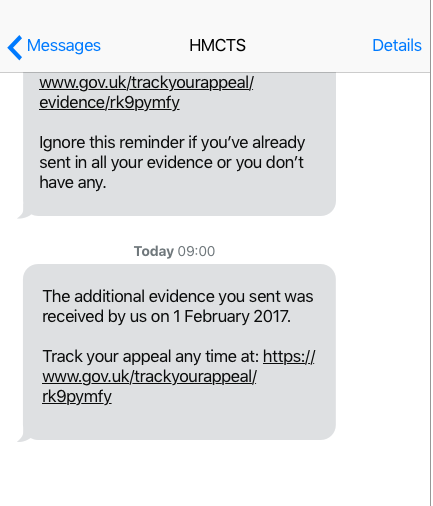[English] - [Cymraeg]
Most digital service teams start by redesigning the beginning of a service’s user journey. But that’s not where the main pain points are for users of the Social Security and Child Support (SSCS) tribunal appeals process. So, following the mantra of putting user needs first, we broke with convention and started in the middle.
An SSCS appeal user’s journey starts with an assessment by the Department for Work and Pensions (DWP) on their entitlement to receive benefits. If a user disagrees with DWP’s final decision they can appeal against it. That appeal is administered by the SSCS tribunal and resolved independently by a panel including a judge.
Appeal pain points
The SSCS tribunal deals with more than 200,000 appeals a year. The vast majority of these are initiated by downloading, filling out and posting a paper form. However cumbersome that may be, our research told us it’s not the biggest pain point in the appeals process.
The most prominent pain point is a lack of understanding about the appeals process and where users are within it. Weeks can go by without any sort of update. Users disengage, miss deadlines or don’t turn up to their hearings. This can lead to adjournments and further delays.
To address this user need, the team concentrated on creating push and pull notifications, or in more user-focussed language, the ability to 'Track your appeal'.
Appeal notifications
We discovered that push notifications can stop anxiety in SSCS users before it happens, so we’ve built a comprehensive set of emails and text messages which are triggered when something important happens during an appeal. This can range from evidence being received to a hearing being booked.

Each notification contains a link to an online service where the user can see the overall appeals process and where they are within it. The online service also provides supporting information on the format of the hearing and how to submit evidence.
What’s planned next
So far, comments from users in our research lab have been overwhelmingly positive. We’ve now reached the time to test it with a controlled group of real SSCS appeal users when we move to Private Beta in the next few months.
We’ve also just created another team who are focussed on improving the process of sharing evidence with the DWP. This will reduce both the amount of time it takes to appeal and the amount of paper generated by the current service.
While our developers are building for Private Beta, our user experience team is turning their attention to Submitting your appeal. This will result in an online submission process which will link up with the Track your appeal section.
I’ll report back again when we’ve combined the middle with the start of the new digital service. Please use the comment section at the bottom of this page to post your questions or to get involved or find out more information please email the SSCS project team.
[English] - [Cymraeg]
Weithiau mae’n gwneud synnwyr i ddechrau yn y canol
Mae’r mwyafrif o dimau gwasanaethau digidol yn dechrau drwy ailgynllunio sut mae siwrnai defnyddiwr gwasanaeth yn cychwyn. Ond nid yn y fan honno mae’r prif rwystrau’n codi i ddefnyddwyr y broses apeliadau Nawdd Cymdeithasol a Chynnal Plant y Tribiwnlysoedd (SSCS). Felly, o ystyried y mantra o roi anghenion y defnyddwyr yn gyntaf, fe wnaethom fynd yn groes i’r arfer a dechrau yn y canol.
Mae siwrnai rhywun sy’n gwneud apêl SSCS yn dechrau gydag asesiad gan Yr Adran Gwaith a Phensiynau (DWP) i sefydlu eu hawl i gael budd-daliadau. Os bydd defnyddiwr yn anghytuno â phenderfyniad terfynol y DWP, gallant apelio yn ei erbyn. Gweinyddir yr apêl honno gan y tribiwnlys SSCS a bydd yn cael ei datrys gan banel a fydd yn cynnwys barnwr.
Rhwystrau mewn perthynas ag apeliadau
Mae’r tribiwnlys SSCS yn delio â mwy na 200,000 o apeliadau y flwyddyn. Mae’r mwyafrif helaeth o’r rhain yn cael eu cychwyn drwy lawrlwytho, llenwi a phostio ffurflen bapur. Pa mor feichus y bo hynny, dangosodd ein gwaith ymchwil wrthym nad yr uchod yw’r rhwystr fwyaf gyda’r broses apelio.
Un o’r rhwystrau mwyaf amlwg yw’r diffyg dealltwriaeth am y broses apelio ac ar ba gam ohoni mae’r defnyddiwr. Gallai wythnosau fynd heibio heb unrhyw fath o ddiweddariad. Mae defnyddwyr yn colli cysylltiad, yn methu terfynau amser, neu nid ydynt yn bresennol yn eu gwrandawiadau. Gall hyn arwain at ohiriadau a rhagor o oedi.
I fynd i’r afael â’r angen hwn o ran y defnyddiwr, canolbwyntiodd y tîm ar greu hysbysiadau gwthio a thynnu, neu mewn iaith sy’n gwneud rhagor o synnwyr i’r defnyddiwr, y gallu i 'ddilyn trywydd eich apêl'.
Hysbysiadau mewn perthynas ag apeliadau
Gwelsom fod hysbysiadau gwthio yn gallu atal defnyddwyr gwasanaeth SSCS rhag bod yn bryderus cyn iddo ddigwydd, felly rydym wedi creu set gynhwysfawr o negeseuon e-bost a negeseuon testun sy’n cael eu hanfon pan mae rhywbeth pwysig yn digwydd yn ystod apêl. Gall hyn amrywio o’r adeg pan mae tystiolaeth yn cyrraedd i’r adeg pan mae gwrandawiad yn cael ei drefnu.
Mae pob hysbysiad yn cynnwys dolen i wasanaeth ar-lein lle gall y defnyddiwr weld y broses apelio o’r dechrau i’r diwedd, ac ar ba gam ohoni maen nhw. Mae’r gwasanaeth ar-lein hefyd yn darparu gwybodaeth gefnogol ar fformat y gwrandawiad a sut i gyflwyno tystiolaeth.
Beth sydd ar y gweill
Hyd yn hyn, mae’r sylwadau gan ein defnyddwyr yn ein labordy ymchwil wedi bod yn gadarnhaol iawn. Rydym bellach wedi cyrraedd yr amser i'w brofi gyda grŵp reoledig o ddefnyddwyr gwasanaeth apeliadau SSCS go iawn pan fyddem yn symud i’r cam Private Beta yn y misoedd nesaf.
Hefyd, rydym newydd greu tîm arall sydd yn canolbwyntio ar wella’r broses o rannu tystiolaeth gyda’r DWP. Bydd hyn yn lleihau'r amser y mae’n cymryd i wneud apêl yn ogystal â faint o bapur sy’n cael ei ddefnyddio gyda’r system bresennol.
Tra bod ein datblygwyr yn paratoi ar gyfer Private Beta, mae ein tîm profiad defnyddwyr yn rhoi sylw i’r adran Cyflwyno eich apêl. Bydd hyn yn arwain at gael proses gyflwyno ar-lein a fydd yn gysylltiedig â’r adran Dilyn trywydd eich apêl.
Byddaf yn adrodd yn ôl pan fyddwn wedi uno canol a dechrau’r gwasanaeth digidol newydd gyda’i gilydd. Defnyddiwch yr adran sylwadau ar waelod y dudalen hon i bostio eich cwestiynau neu i gymryd rhan. I ddod o hyd i ragor o wybodaeth, anfonwch e-bost at dîm prosiect SSCS y tribiwnlys.

6 comments
Comment by Anne Ruff TJ posted on
Pleased that some information about this project is now being circulated.
Can you provide more details about the "research lab" and the "user experience team" eg the background of the researchers/ the team (admin, legal or IT), details about the project (aims, where, who, when) and the overall timescale, as well as to what extent the judiciary (both salaried and fee paid) as a whole will be consulted.
Comment by Robin Marchant posted on
Anne, thank you for your response to the blog. A user experience team help us understand the needs of users through a variety of methods and techniques including observations, interviews and research lab sessions – for “Track your Appeal “ this has already included sessions with appellants, representatives, judiciary and HMCTS staff. We will continue this approach to user led design so we will be talking to and working with the judiciary throughout. There is more information about the approach of user experience teams at http://www.gov.uk/service-manual
We hope to pilot “track your appeal” in the spring and will look to provides further updates on this new digital service regularly. Hope this helps and thank you for the feedback.
Comment by John posted on
This sounds like a welcome improvement to the current paper chase. For the moment though are you only focussing on DWP decisions? As an LA user I'm more interested in HB appeals - although as UC take up accelerates there will be a gradual but significant fall in working age HB caseloads and therefore less appeals. So I guess this won't be a priority for a while yet (if ever).
cheers
Comment by Robin Marchant posted on
John, thanks for your comment. The blog refers to DWP as they are the main respondent in SSCS tribunal cases, so that is where we are starting and will be testing first. We do aim for the digital service to be in place for all appellants who need to use the tribunal. We’ll provide regular updates on our work on this blog. Thanks for the feedback.
Comment by Eliot posted on
This is great to see happening. Hope to see more of reform ideas being tested and iterated more publicly. Keep up the good work.
Will you be publishing service assessments and publishing data to the performance platform?
Comment by Robin Marchant posted on
Eliot, thanks for your comment and glad you found the information useful. We’ll share more information as the service develops including progress through service assessments and the performance and data results through our ongoing user research.